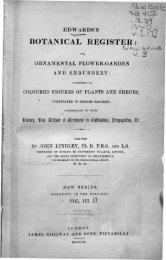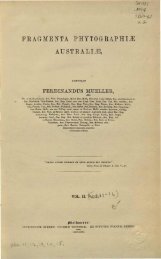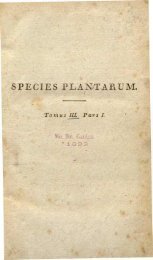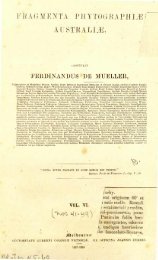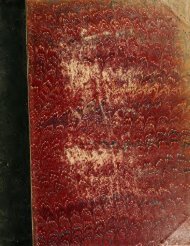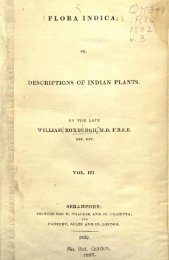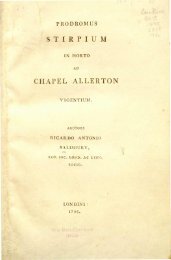Botanical Magazine 106 - 1880.pdf - hibiscus.org
Botanical Magazine 106 - 1880.pdf - hibiscus.org
Botanical Magazine 106 - 1880.pdf - hibiscus.org
Create successful ePaper yourself
Turn your PDF publications into a flip-book with our unique Google optimized e-Paper software.
TAB. 6484.<br />
CONANDRON RAMONDIOIDIS.<br />
Native of Japan.<br />
Nat. Orel. GESNERACE.E.•Tribe CYRTANDREíE.<br />
Genus CONANDRON, Sieb, et Zuce.; (Benth. et Hook. f. Gen. PL vol. ii. p. 1021.)<br />
CONANDRON ramondioides ; acaulis, rbizomate subtuberoso aplce viilis seiieeis<br />
brunneis onusto, foliis oblongo- v. elliptico-ovatis subsessilibus v. in petiolum<br />
nudum v. late alatum eroso-dentatum contractas, acutis v. acuminatis irregula-<br />
riter argute eroso-dentatis membranaeeis glabiis, basi interdum valde obliquo<br />
v. insequali cordato v. abrupte v. sensim angustato, scapis nudis hirsutis v.<br />
glabratis, cymis multifloris nutantibus, floribus pedicellatis albis v. roséis,<br />
calycis laciniis linearibus.<br />
C. ramondioides, Sieb, et Zuce, in Abh. Munch. Alead, vol. iü. 2, p. 729, t. 3, f. 1 ;<br />
Miquel, Prolus. FI. Japon, p. 55 ; A. DC. Prodr. vol. ix. p. 273 ; Maximo».<br />
in Bull. Acad. Petersb. vol. xix. p. 537 ; Mel. Biol. vol. ix. p. 370 ; Masters<br />
in Gard. Chron. 1879, p. 232.<br />
This very interesting plant has been elaborately described<br />
by Dr. Masters in the " Gardeners' Chronicle " cited above,<br />
and to its description that botanist has added full observa-<br />
tions on its affinities and geographical relations to various<br />
allied or similar plants. The sum of these latter is, that<br />
Conandron is an aberrant member of a group of Gesnera-<br />
ceous plants, which spans the middle mountain regions of<br />
the Old World from Spain to Japan. Thus, it is represented<br />
in the Western Pyrenees by Ramondia pyrenaica (see Tab.<br />
236, Verbascum Myconi), which indeed is its nearest relative ;<br />
by a second species of that genus in Greece, by a third in<br />
Servia, and by Baberlea in the Balkan. From this last<br />
point there is a hiatus, till the Himalaya are reached, no<br />
representative having been hitherto discovered in the<br />
Caucasus or mountains of N. Persia ; but in the Himalaya<br />
Didymocarpus takes up the eastward representation, and<br />
B•a (see Tab. 6468) terminates it in N. China. Wulfenia,<br />
which is European and Himalayan, is intercalated by Dr.<br />
Masters, as is the Japanese and American genus Shortia ;<br />
but these have, I think, no affinity with the above or with<br />
MARCH 1ST, 1880.




